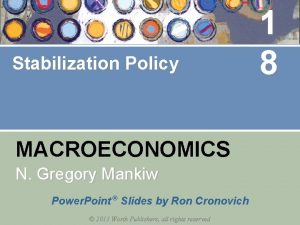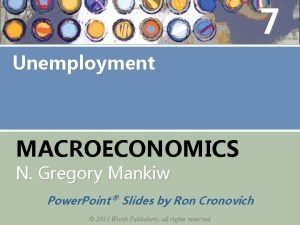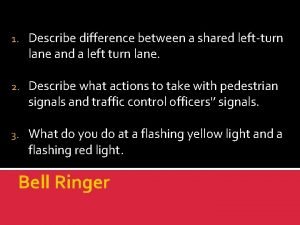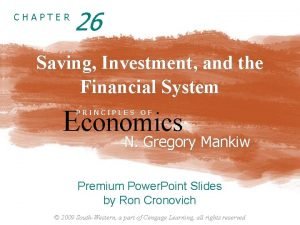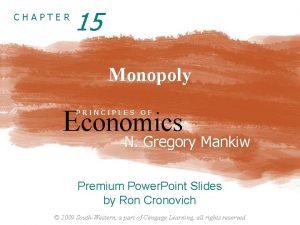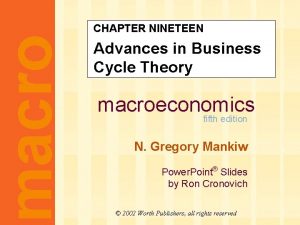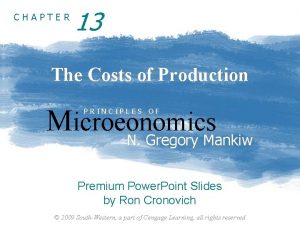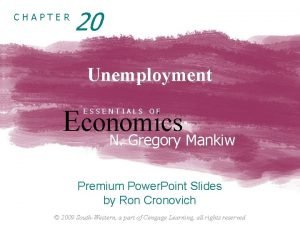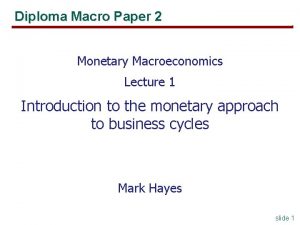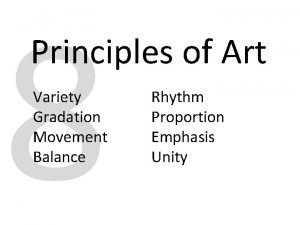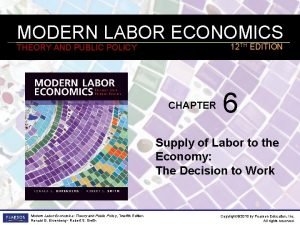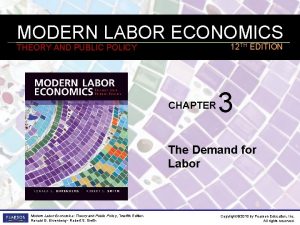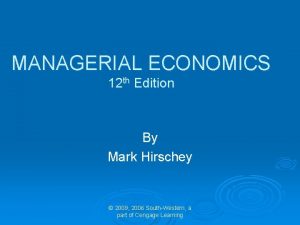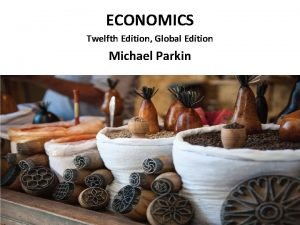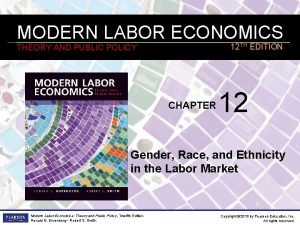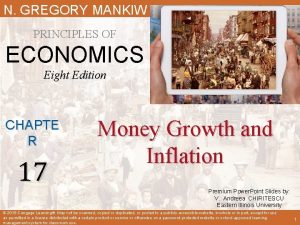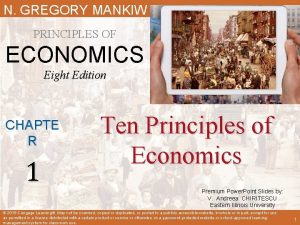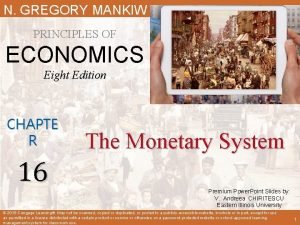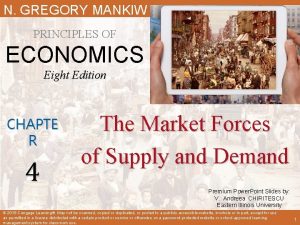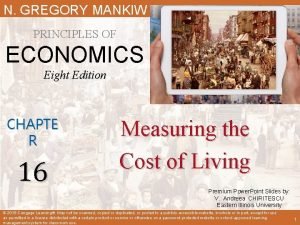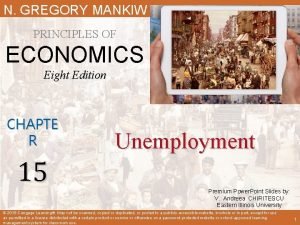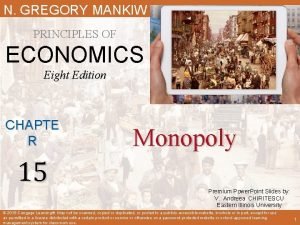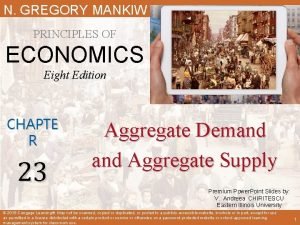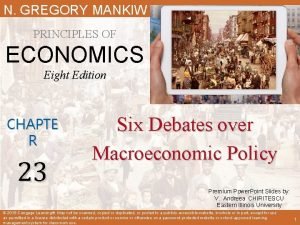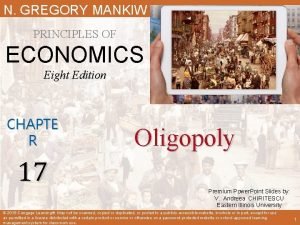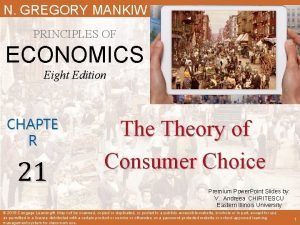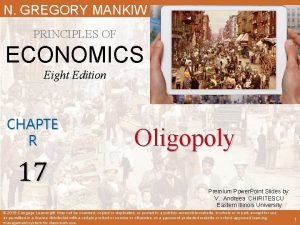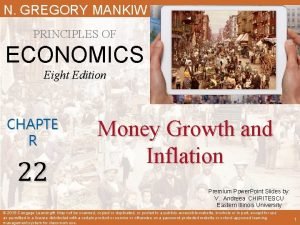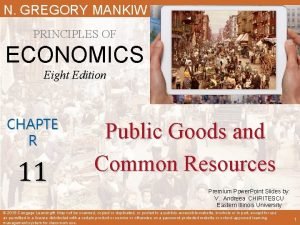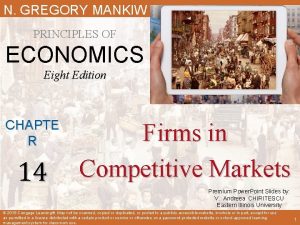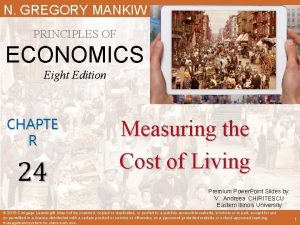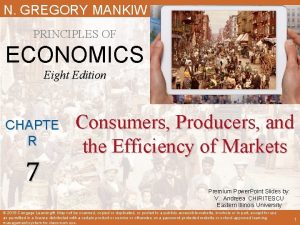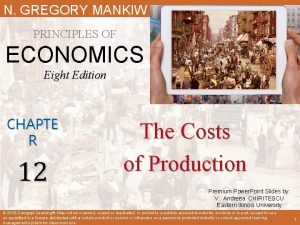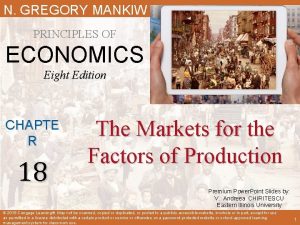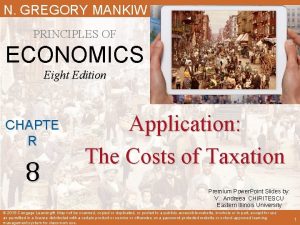N GREGORY MANKIW PRINCIPLES OF ECONOMICS Eight Edition



























- Slides: 27

N. GREGORY MANKIW PRINCIPLES OF ECONOMICS Eight Edition CHAPTE R 21 Theory of Consumer Choice Premium Power. Point Slides by: V. Andreea CHIRITESCU Eastern Illinois University © 2018 Cengage Learning®. May not be scanned, copied or duplicated, or posted to a publicly accessible website, in whole or in part, except for use as permitted in a license distributed with a certain product or service or otherwise on a password-protected website or school-approved learning management system for classroom use. 1

Look for the answers to these questions: • How does the budget constraint represent the choices a consumer can afford? • How do indifference curves represent the consumer’s preferences? • What determines how a consumer divides her resources between two goods? • How does theory of consumer choice explain decisions such as how much a consumer saves, or how much labor she supplies? © 2018 Cengage Learning®. May not be scanned, copied or duplicated, or posted to a publicly accessible website, in whole or in part, except for use as permitted in a license distributed with a certain product or service or otherwise on a password-protected website or school-approved learning management system for classroom use. 2

Introduction • People face tradeoffs. – Buying more of one good leaves less income to buy other goods – Working more hours means more income and more consumption, but less leisure time – Reducing saving allows more consumption today but reduces future consumption This chapter explores how consumers make choices like these. © 2018 Cengage Learning®. May not be scanned, copied or duplicated, or posted to a publicly accessible website, in whole or in part, except for use as permitted in a license distributed with a certain product or service or otherwise on a password-protected website or school-approved learning management system for classroom use. 3

The Budget Constraint: What the Consumer Can Afford • Budget constraint: – The limit on the consumption bundles that a consumer can afford • Example: – Hurley divides his income between two goods: fish and mangos. – A “consumption bundle” is a particular combination of the goods, e. g. , 40 fish & 300 mangos © 2018 Cengage Learning®. May not be scanned, copied or duplicated, or posted to a publicly accessible website, in whole or in part, except for use as permitted in a license distributed with a certain product or service or otherwise on a password-protected website or school-approved learning management system for classroom use. 4

Active Learning 1 The budget constraint Hurley’s income: $1200 Prices: PF = $4 per fish, PM = $1 per mango A. If Hurley spends all his income on fish, how many fish does he buy? B. If Hurley spends all his income on mangos, how many mangos does he buy? C. If Hurley buys 100 fish, how many mangos can he buy? D. Plot each of the bundles from parts A – C on a graph that measures fish on the horizontal axis and mangos on the vertical; connect the dots. © 2018 Cengage Learning®. May not be scanned, copied or duplicated, or posted to a publicly accessible website, in whole or in part, except for use as permitted in a license distributed with a certain product or service or otherwise on a password-protected website or school-approved learning management system for classroom use. 5

Active Learning 1 A. $1200/$4 = 300 fish Quantity of Mangos B. $1200/$1 = 1200 mangos C. 100 fish cost $400, $800 left buys 800 mangos Answers B D. Hurley’s budget constraint shows the bundles he can afford. C A Quantity of Fish © 2018 Cengage Learning®. May not be scanned, copied or duplicated, or posted to a publicly accessible website, in whole or in part, except for use as permitted in a license distributed with a certain product or service or otherwise on a password-protected website or school-approved learning management system for classroom use. 6

Active Learning 1 From C to The Slope of the Budget Constraint The slope of the budget constraint equals the relative price of the good on the X axis. Quantity of D, Mangos “rise” = – 200 mangos “run” = +50 fish C D Slope = – 4 Hurley must give up 4 mangos to get one fish. Quantity of Fish © 2018 Cengage Learning®. May not be scanned, copied or duplicated, or posted to a publicly accessible website, in whole or in part, except for use as permitted in a license distributed with a certain product or service or otherwise on a password-protected website or school-approved learning management system for classroom use. 7

Active Learning 2 The budget constraint, continued Initial problem: Hurley’s income: $1200 Prices: PF = $4 per fish, PM = $1 per mango Show what happens to Hurley’s budget constraint if: A. His income falls to $800. B. The price of mangos rises to PM = $2 per mango © 2018 Cengage Learning®. May not be scanned, copied or duplicated, or posted to a publicly accessible website, in whole or in part, except for use as permitted in a license distributed with a certain product or service or otherwise on a password-protected website or school-approved learning management system for classroom use. 8

Active Learning 2 Now, Hurley can buy Quantity of Mangos $800/$4 = 200 fish Answers, part A A fall in income shifts the budget constraint down. or $800/$1 = 800 mangos or any combination in between. Quantity of Fish © 2018 Cengage Learning®. May not be scanned, copied or duplicated, or posted to a publicly accessible website, in whole or in part, except for use as permitted in a license distributed with a certain product or service or otherwise on a password-protected website or school-approved learning management system for classroom use. 9

Active Learning 2 Hurley can still buy 300 fish. Quantity of Mangos But now he can only buy $1200/$2 = 600 mangos. Notice: slope is smaller, relative price of fish is now only 2 mangos Answers, part B An increase in the price of one good pivots the budget constraint inward. Quantity of Fish © 2018 Cengage Learning®. May not be scanned, copied or duplicated, or posted to a publicly accessible website, in whole or in part, except for use as permitted in a license distributed with a certain product or service or otherwise on a password-protected website or school-approved learning management system for classroom use. 10

Preferences: What the Consumer Wants Indifference curve: shows consumption bundles that give the consumer the same level of satisfaction A, B, and all other bundles on I 1 make Hurley equally happy: he is indifferent between them. Quantity of Mangos One of Hurley’s indifference curves B A I 1 Quantity of Fish © 2018 Cengage Learning®. May not be scanned, copied or duplicated, or posted to a publicly accessible website, in whole or in part, except for use as permitted in a license distributed with a certain product or service or otherwise on a password-protected website or school-approved learning management system for classroom use. 11

Four Properties of Indifference Curves 1. Indifference curves are downwardsloping. One of Hurley’s Quantity If the quantity of fish is reduced, the quantity of mangos must be increased to keep Hurley equally happy. of Mangos indifference curves B A I 1 Quantity of Fish © 2018 Cengage Learning®. May not be scanned, copied or duplicated, or posted to a publicly accessible website, in whole or in part, except for use as permitted in a license distributed with a certain product or service or otherwise on a password-protected website or school-approved learning management system for classroom use. 12

Four Properties of Indifference Curves 2. Higher indifference curves are preferred to lower ones. A few of Hurley’s Quantity indifference curves of Mangos Hurley prefers every bundle on I 2 (like C) to every bundle on I 1 (like A). He prefers every bundle on I 1 (like A) to every bundle on I 0 (like D). C D I 2 A I 1 I 0 Quantity of Fish © 2018 Cengage Learning®. May not be scanned, copied or duplicated, or posted to a publicly accessible website, in whole or in part, except for use as permitted in a license distributed with a certain product or service or otherwise on a password-protected website or school-approved learning management system for classroom use. 13

Four Properties of Indifference Curves 3. Indifference curves cannot cross. Suppose they did. Hurley should prefer B to C, since B has more of both goods. Yet, Hurley is indifferent between B and C: He likes C as much as A (both are on I 4). He likes A as much as B (both are on I 1). Quantity of Mangos Hurley’s indifference curves B C A I 1 I 4 Quantity of Fish © 2018 Cengage Learning®. May not be scanned, copied or duplicated, or posted to a publicly accessible website, in whole or in part, except for use as permitted in a license distributed with a certain product or service or otherwise on a password-protected website or school-approved learning management system for classroom use. 14

Four Properties of Indifference Curves 4. Indifference curves are bowed inward. Hurley is willing to give up more mangos for a fish if he has few fish (A) than if he has many (B). Quantity of Mangos A 6 1 2 B 1 I 1 Quantity of Fish © 2018 Cengage Learning®. May not be scanned, copied or duplicated, or posted to a publicly accessible website, in whole or in part, except for use as permitted in a license distributed with a certain product or service or otherwise on a password-protected website or school-approved learning management system for classroom use. 15

The Marginal Rate of Substitution Marginal rate of substitution (MRS): Quantity the rate at which a of Mangos consumer is willing to trade one good for another. MRS = slope of indifference curve A Hurley’s MRS is the amount. MRS = 6 of mangos he would 1 substitute for another fish. MRS = 2 MRS falls as you move down along an indifference curve. B 1 I 1 Quantity of Fish © 2018 Cengage Learning®. May not be scanned, copied or duplicated, or posted to a publicly accessible website, in whole or in part, except for use as permitted in a license distributed with a certain product or service or otherwise on a password-protected website or school-approved learning management system for classroom use. 16

One Extreme Case: Perfect Substitutes Perfect substitutes: two goods with straight-line indifference curves, constant MRS Example: nickels and dimes Consumer is always willing to trade two nickels for one dime. © 2018 Cengage Learning®. May not be scanned, copied or duplicated, or posted to a publicly accessible website, in whole or in part, except for use as permitted in a license distributed with a certain product or service or otherwise on a password-protected website or school-approved learning management system for classroom use. 17

Another Extreme Case: Perfect Complements Perfect complements: two goods with right-angle indifference curves Example: Left shoes, right shoes {7 left shoes, 5 right shoes} is just as good as {5 left shoes, 5 right shoes} © 2018 Cengage Learning®. May not be scanned, copied or duplicated, or posted to a publicly accessible website, in whole or in part, except for use as permitted in a license distributed with a certain product or service or otherwise on a password-protected website or school-approved learning management system for classroom use. 18

Less Extreme Cases: Close Substitutes and Close Complements Quantity of Pepsi Indifference curves for close substitutes are not very bowed Quantity of Coke Quantity of hot dog buns Indifference curves for close complements are very bowed Quantity of hot dogs © 2018 Cengage Learning®. May not be scanned, copied or duplicated, or posted to a publicly accessible website, in whole or in part, except for use as permitted in a license distributed with a certain product or service or otherwise on a password-protected website or school-approved learning management system for classroom use. 19

Optimization: What the Consumer Chooses A is the optimum: the point on the budget constraint that touches the highest possible indifference curve. Hurley prefers B to A, but he cannot afford B. Hurley can afford C and D, but A is on a higher indifference curve. Quantity of Mangos The optimum is the bundle Hurley most prefers out of all the bundles he can afford. 1200 B A 600 C D 150 300 Quantity of Fish © 2018 Cengage Learning®. May not be scanned, copied or duplicated, or posted to a publicly accessible website, in whole or in part, except for use as permitted in a license distributed with a certain product or service or otherwise on a password-protected website or school-approved learning management system for classroom use. 20

Optimization: What the Consumer Chooses At the optimum, slope of the indifference curve equals slope of the budget constraint: Quantity of Mangos MRS = PF / PM marginal value of fish (in terms of mangos) price of fish (in terms of mangos) Consumer optimization is another example of “thinking at the margin. ” 1200 600 A 150 300 Quantity of Fish © 2018 Cengage Learning®. May not be scanned, copied or duplicated, or posted to a publicly accessible website, in whole or in part, except for use as permitted in a license distributed with a certain product or service or otherwise on a password-protected website or school-approved learning management system for classroom use. 21

Conclusion: Do People Really Think This Way? • People do not make spending decisions by writing down their budget constraints and indifference curves. – Yet, they try to make the choices that maximize their satisfaction given their limited resources. – The theory in this chapter is only intended as a metaphor for how consumers make decisions. – It explains consumer behavior fairly well in many situations and provides the basis for more advanced economic analysis. © 2018 Cengage Learning®. May not be scanned, copied or duplicated, or posted to a publicly accessible website, in whole or in part, except for use as permitted in a license distributed with a certain product or service or otherwise on a password-protected website or school-approved learning management system for classroom use. 22

Summary • A consumer’s budget constraint shows the possible combinations of different goods she can buy given her income and the prices of the goods. • The slope of the budget constraint equals the relative price of the goods. • An increase in income shifts the budget • constraint outward. A change in the price of one of the goods pivots the budget constraint. © 2018 Cengage Learning®. May not be scanned, copied or duplicated, or posted to a publicly accessible website, in whole or in part, except for use as permitted in a license distributed with a certain product or service or otherwise on a password-protected website or school-approved learning management system for classroom use. 23

Summary • A consumer’s indifference curves represent her preferences. • An indifference curve shows all the bundles that • give the consumer a certain level of happiness. The consumer prefers points on higher indifference curves to points on lower ones. • The slope of an indifference curve at any point is the marginal rate of substitution • MRS = rate at which the consumer is willing to trade one good for the other. © 2018 Cengage Learning®. May not be scanned, copied or duplicated, or posted to a publicly accessible website, in whole or in part, except for use as permitted in a license distributed with a certain product or service or otherwise on a password-protected website or school-approved learning management system for classroom use. 24

Summary • The consumer optimizes by choosing the point on her budget constraint that lies on the highest indifference curve. • At this point, the marginal rate of substitution equals the relative price of the two goods. • When the price of a good falls, the impact on the consumer’s choices can be broken down into two effects, an income effect and a substitution effect. © 2018 Cengage Learning®. May not be scanned, copied or duplicated, or posted to a publicly accessible website, in whole or in part, except for use as permitted in a license distributed with a certain product or service or otherwise on a password-protected website or school-approved learning management system for classroom use. 25

Summary • The income effect is the change in consumption that arises because a lower price makes the consumer better off. • Movement from a lower indifference curve to a higher one. • The substitution effect is the change that arises because a price change encourages greater consumption of the good that has become relatively cheaper. • Movement along an indifference curve. © 2018 Cengage Learning®. May not be scanned, copied or duplicated, or posted to a publicly accessible website, in whole or in part, except for use as permitted in a license distributed with a certain product or service or otherwise on a password-protected website or school-approved learning management system for classroom use. 26

Summary • The theory of consumer choice can be applied in many situations. • It can explain why demand curves can potentially slope upward, why higher wages could either increase or decrease labor supply, and why higher interest rates could either increase or decrease saving. © 2018 Cengage Learning®. May not be scanned, copied or duplicated, or posted to a publicly accessible website, in whole or in part, except for use as permitted in a license distributed with a certain product or service or otherwise on a password-protected website or school-approved learning management system for classroom use. 27
 Principles of economics mankiw 9th edition ppt
Principles of economics mankiw 9th edition ppt Principles of economics mankiw 9th edition ppt
Principles of economics mankiw 9th edition ppt Macroeconomics
Macroeconomics Principle of economics third edition
Principle of economics third edition Principles of economics sixth edition
Principles of economics sixth edition A polygon with eight sides and eight angles
A polygon with eight sides and eight angles A short section of corrugated roadway that warns of hazards
A short section of corrugated roadway that warns of hazards Chapter 26 saving investment and the financial system
Chapter 26 saving investment and the financial system Chapter 15 monopoly
Chapter 15 monopoly Site:slidetodoc.com
Site:slidetodoc.com Chapter 13 the cost of production
Chapter 13 the cost of production Intermediate macroeconomics mankiw
Intermediate macroeconomics mankiw Mankiw slides
Mankiw slides Mankiw
Mankiw Evolution of eia
Evolution of eia 8 principles of art
8 principles of art Eight principles of software engineering
Eight principles of software engineering Using mis 10th edition
Using mis 10th edition Zulily case study
Zulily case study Modern labor economics 12th edition solution
Modern labor economics 12th edition solution Vertical economics
Vertical economics Parkin macroeconomics 13th edition pdf
Parkin macroeconomics 13th edition pdf Managerial economics 12th edition mark hirschey
Managerial economics 12th edition mark hirschey Markup economics
Markup economics Modern labor economics 12th edition
Modern labor economics 12th edition Maastricht university economics and business economics
Maastricht university economics and business economics Econ213
Econ213 Principles of information security 5th edition pdf
Principles of information security 5th edition pdf
